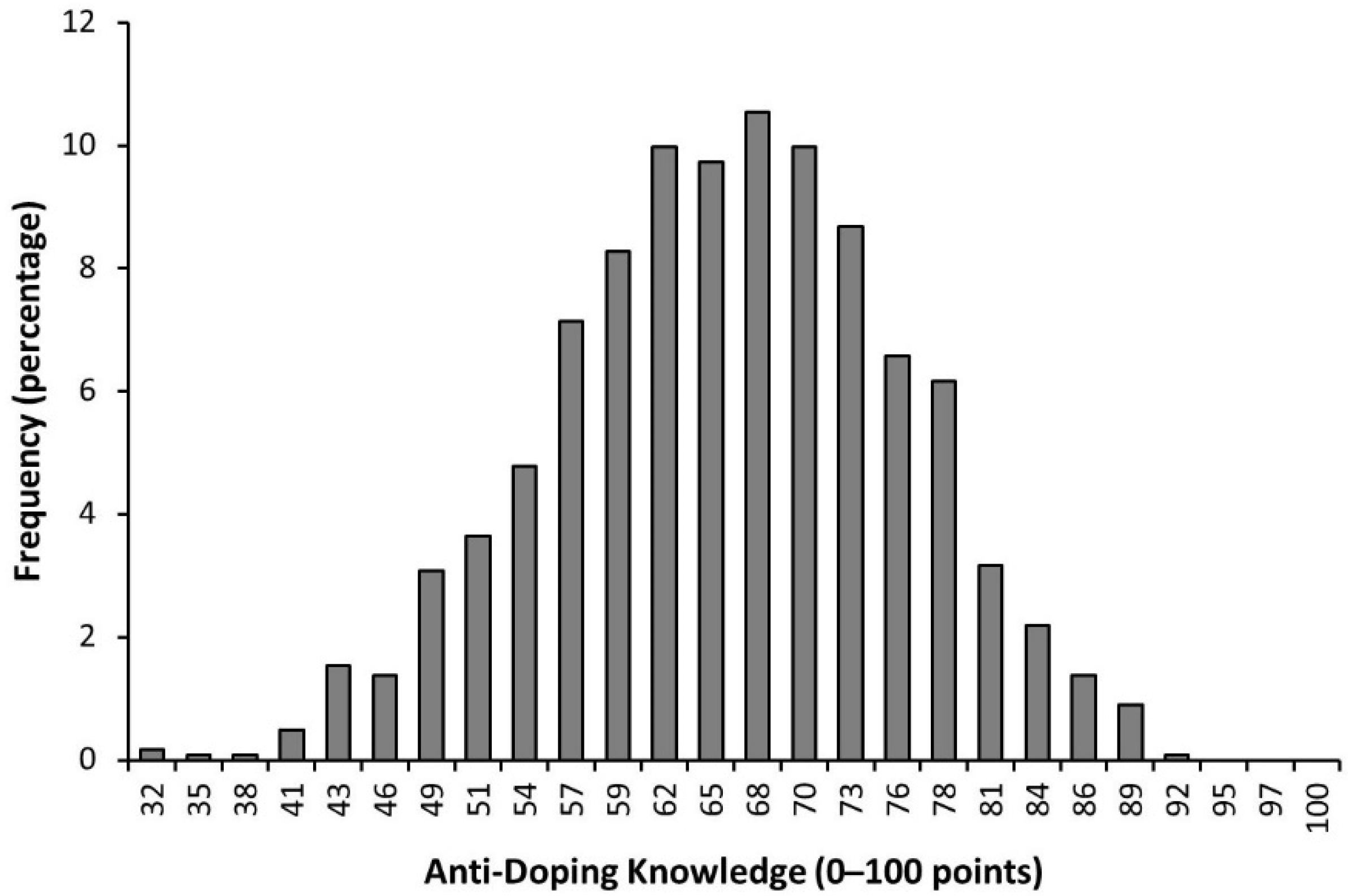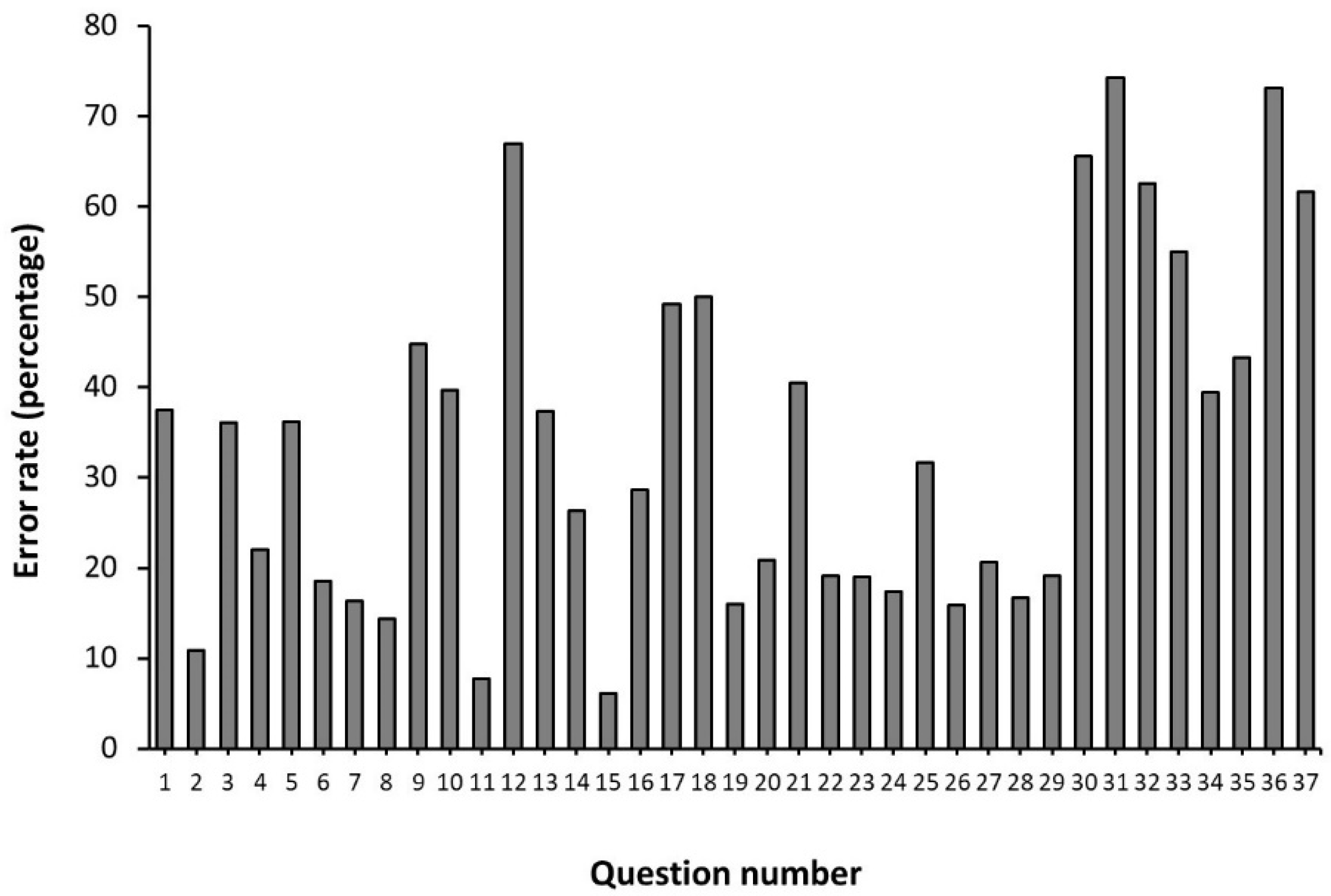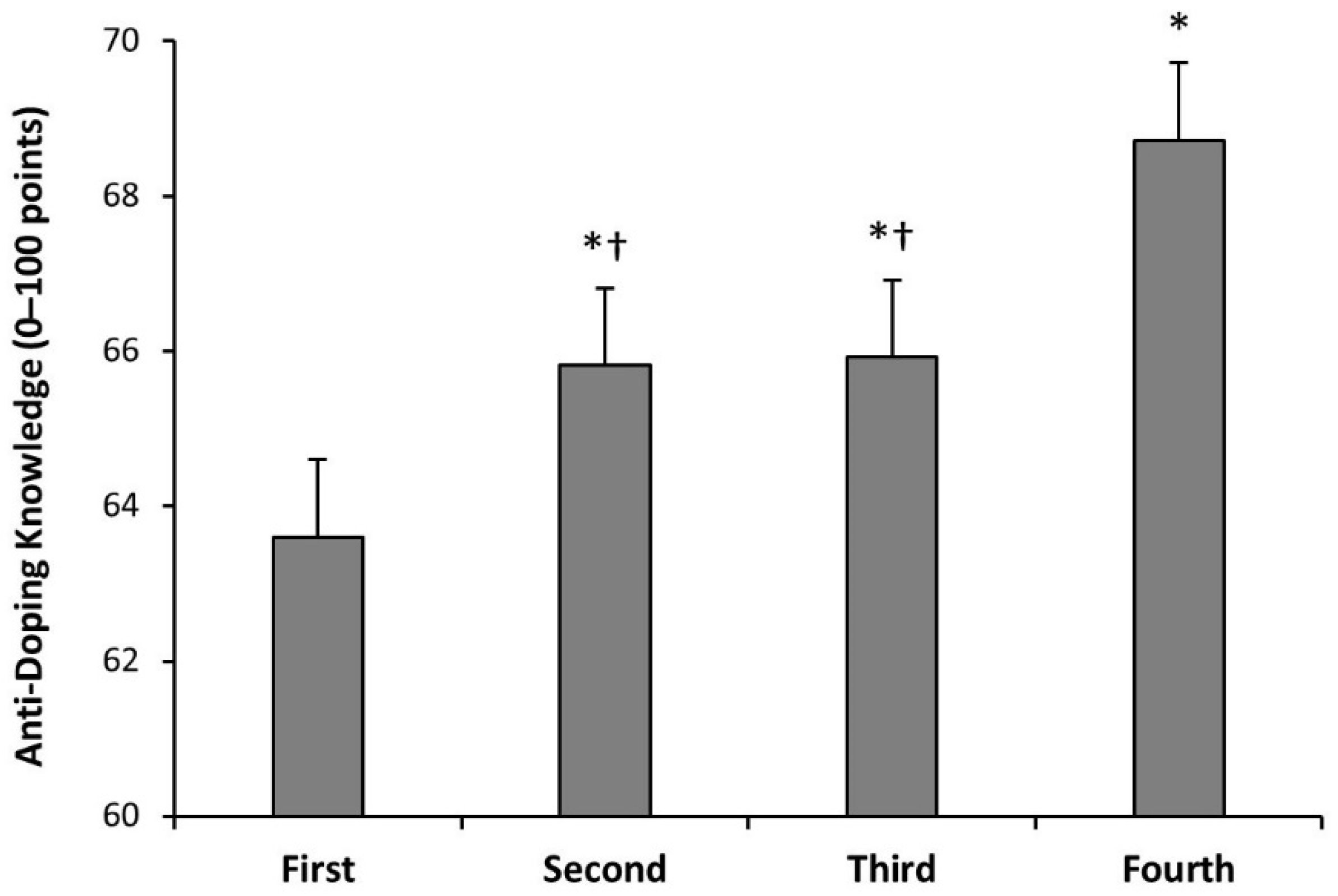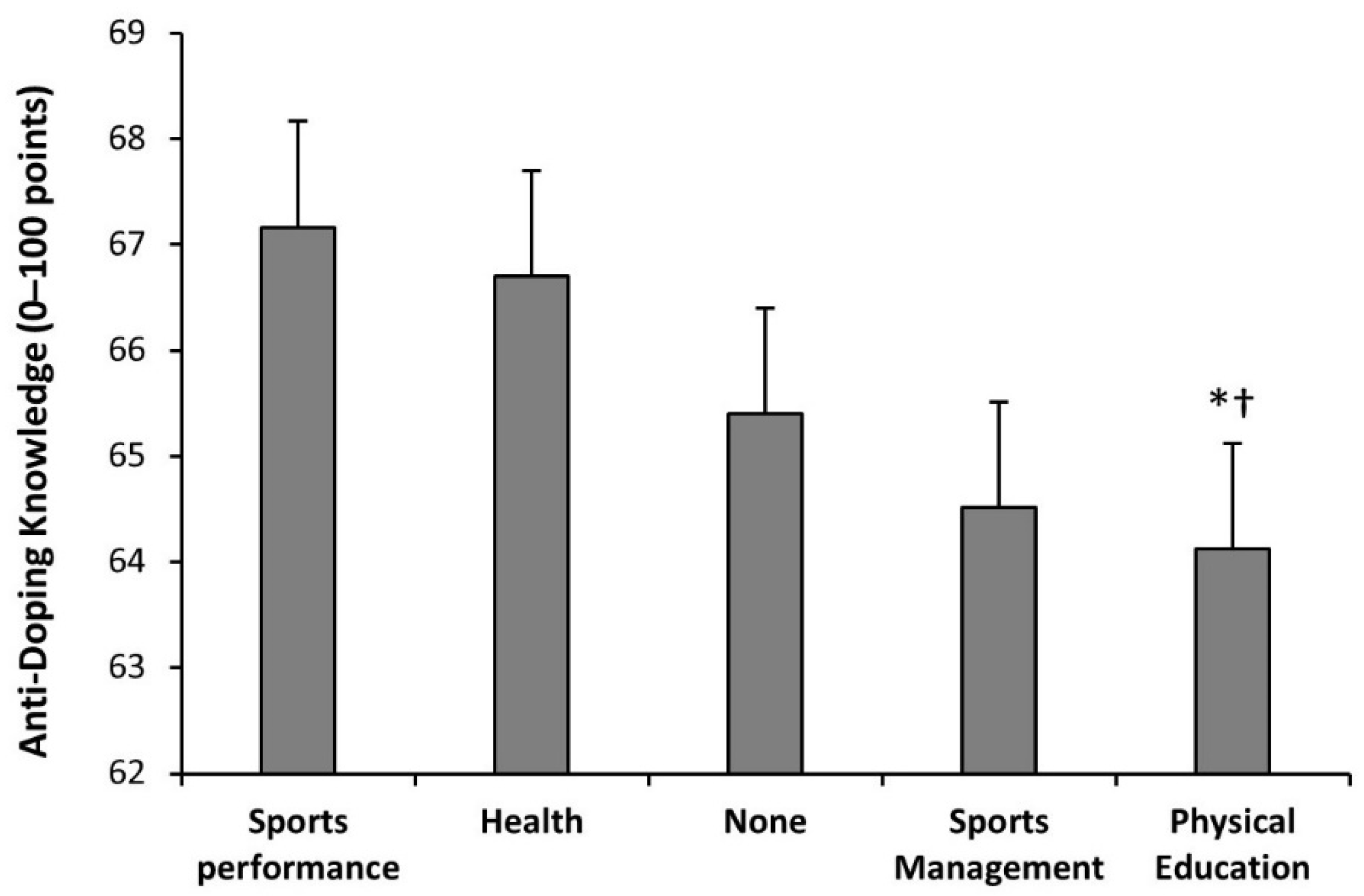Anti-Doping Knowledge of Students Undertaking Bachelor’s Degrees in Sports Sciences in Spain
Abstract
:1. Introduction
2. Materials and Methods
2.1. Participants
2.2. Questionnaire and Data Collection
2.3. Statistical Analysis
3. Results
4. Discussion
5. Conclusions
Author Contributions
Funding
Institutional Review Board Statement
Informed Consent Statement
Data Availability Statement
Acknowledgments
Conflicts of Interest
Appendix A. Adapted Version of the WADA Play True Quiz
References
- Bytomski, J.R. Fueling for Performance. Sports Health 2018, 10, 47. [Google Scholar] [CrossRef] [PubMed]
- Maughan, R.J.; Burke, L.M.; Dvorak, J.; Larson-Meyer, D.E.; Peeling, P.; Phillips, S.M.; Rawson, E.S.; Walsh, N.P.; Garthe, I.; Geyer, H.; et al. IOC consensus statement: Dietary supplements and the high-performance athlete. Br. J. Sports Med. 2018, 52, 439–455. [Google Scholar] [CrossRef] [PubMed]
- Baltazar-Martins, G.; Brito de Souza, D.; Aguilar-Navarro, M.; Muñoz-Guerra, J.; Plata, M.D.M.; Del Coso, J. Prevalence and patterns of dietary supplement use in elite Spanish athletes. J. Int. Soc. Sports Nutr. 2019, 16, 30. [Google Scholar] [CrossRef] [PubMed] [Green Version]
- Martínez-Sanz, M.J.; Sospedra, I.; Ortiz, M.C.; Baladía, E.; Gil-Izquierdo, A.; Ortiz-Moncada, R. Intended or Unintended Doping? A Review of the Presence of Doping Substances in Dietary Supplements Used in Sports. Nutrients 2017, 9, 1093. [Google Scholar] [CrossRef] [Green Version]
- UK Anti-Doping Athlete Support Personnel. Available online: https://www.ukad.org.uk/athlete-support-personnel (accessed on 27 September 2022).
- Petróczi, A. Attitudes and doping: A structural equation analysis of the relationship between athletes’ attitudes, sport orientation and doping behaviour. Subst. Abus. Treat. Prev. Policy 2007, 2, 34. [Google Scholar] [CrossRef] [Green Version]
- Mallia, L.; Lucidi, F.; Zelli, A.; Violani, C. Doping Attitudes and the Use of Legal and Illegal Performance-Enhancing Substances Among Italian Adolescents. J. Child Adolesc. Subst. Abus. 2013, 22, 179–190. [Google Scholar] [CrossRef]
- Barkoukis, V.; Kartali, K.; Lazuras, L.; Tsorbatzoudis, H. Evaluation of an anti-doping intervention for adolescents: Findings from a school-based study. Sport Manag. Rev. 2016, 19, 23–34. [Google Scholar] [CrossRef]
- World Anti-Doping Agency World Anti-Doping Code|World Anti-Doping Agency. Available online: https://www.wada-ama.org/en/what-we-do/world-anti-doping-code (accessed on 1 July 2022).
- Codella, R.; Glad, B.; Luzi, L.; La Torre, A. An Italian Campaign to Promote Anti-doping Culture in High-School Students. Front. Psychol. 2019, 10, 534. [Google Scholar] [CrossRef] [Green Version]
- Murofushi, Y.; Kawata, Y.; Kamimura, A.; Hirosawa, M.; Shibata, N. Impact of anti-doping education and doping control experience on anti-doping knowledge in Japanese university athletes: A cross-sectional study. Subst. Abus. Treat. Prev. Policy 2018, 13, 44. [Google Scholar] [CrossRef]
- Mazanov, J.; Backhouse, S.; Connor, J.; Hemphill, D.; Quirk, F. Athlete support personnel and anti-doping: Knowledge, attitudes, and ethical stance. Scand. J. Med. Sci. Sports 2014, 24, 846–856. [Google Scholar] [CrossRef]
- Morente-Sánchez, J.; Zabala, M. Knowledge, attitudes and beliefs of technical staff towards doping in Spanish football. J. Sports Sci. 2015, 33, 1267–1275. [Google Scholar] [CrossRef] [PubMed]
- Backhouse, S.; McKenna, J.; Patterson, L. Prevention through Education—A Review of Current International Social Science Literature|World Anti-Doping Agency. Available online: https://www.wada-ama.org/en/resources/prevention-through-education-review-current-international-social-science-literature#resource-download (accessed on 17 October 2022).
- Lucidi, F.; Mallia, L.; Alivernini, F.; Chirico, A.; Manganelli, S.; Galli, F.; Biasi, V.; Zelli, A. The Effectiveness of a New School-Based Media Literacy Intervention on Adolescents’ Doping Attitudes and Supplements Use. Front. Psychol. 2017, 8, 749. [Google Scholar] [CrossRef] [PubMed] [Green Version]
- Eysenbach, G. Improving the Quality of Web Surveys: The Checklist for Reporting Results of Internet E-Surveys (CHERRIES). J. Med. Internet Res. 2004, 6, e34, Erratum in J. Med. Internet Res. 2012, 14, e8. [Google Scholar] [CrossRef]
- World Anti-Doping Agency Play True Quiz|World Anti-Doping Agency. Available online: https://www.wada-ama.org/en/resources/play-true-quiz (accessed on 1 July 2022).
- Dunn, J.G.H.; Bouffard, M.; Rogers, W.T. Assessing Item Content-Relevance in Sport Psychology Scale-Construction Research: Issues and Recommendations. Meas. Phys. Educ. Exerc. Sci. 2009, 3, 15–36. [Google Scholar] [CrossRef]
- Thomas, J.R.; Nelson, J.K. Métodos de Investigación en Actividad Física; Paidotribo: Madrid, Spain, 2007; ISBN 8480198702. [Google Scholar]
- Baumgartner, T.A. Estimating the Stability Reliability of a Score. Meas. Phys. Educ. Exerc. Sci. 2009, 4, 175–178. [Google Scholar] [CrossRef]
- Henning, A. Challenges to promoting health for amateur athletes through anti-doping policy. Drugs 2017, 24, 306–313. [Google Scholar] [CrossRef] [PubMed] [Green Version]
- World Anti-Doping Agency. WADA Launches New and Improved Anti-Doping Education and Learning Platform (ADEL)|World Anti-Doping Agency. Available online: https://www.wada-ama.org/en/news/wada-launches-new-and-improved-anti-doping-education-and-learning-platform-adel (accessed on 22 June 2022).
- Engelberg, T.; Moston, S. Inside the locker room: A qualitative study of coaches’ anti-doping knowledge, beliefs and attitudes. Sport Soc. 2016, 19, 942–956. [Google Scholar] [CrossRef]
- Awaisu, A.; Mottram, D.; Rahhal, A.; Alemrayat, B.; Ahmed, A.; Stuart, M.; Khalifa, S. Knowledge and perceptions of pharmacy students in Qatar on anti-doping in sports and on sports pharmacy in undergraduate curricula. Am. J. Pharm. Educ. 2015, 79, 119. [Google Scholar] [CrossRef] [PubMed] [Green Version]
- Rintaugul, E.G.; Mwangi, F.M. Knowledge, attitudes and perceptions on doping among university students in physical education and sport science related degree programmes. J. Hum. Sport Exerc. 2021, 16, 174–186. [Google Scholar]
- Spanish Commission for Anti-Doping in Sport Spanish Commission for Anti-Doping in Sport. Available online: https://celad.culturaydeporte.gob.es/inicio.html (accessed on 1 July 2022).
- World Anti-Doping Agency International Standard for Education. Available online: https://www.wada-ama.org/en/resources/world-anti-doping-program/international-standard-education-ise (accessed on 1 July 2022).
- Puchades, M.; Molina, P. Attitudes towards doping among sport sciences students. Apunt. Educ. Fis. Deport. 2020, 140, 1–7. [Google Scholar] [CrossRef]
- Sagoe, D.; Holden, G.; Rise, E.N.K.; Torgersen, T.; Paulsen, G.; Krosshaug, T.; Lauritzen, F.; Pallesen, S. Doping prevention through anti-doping education and practical strength training: The Hercules program. Perform. Enhanc. Health 2016, 5, 24–30. [Google Scholar] [CrossRef]
- Dickinson, A.; Mackay, D. Health habits and other characteristics of dietary supplement users: A review. Nutr. J. 2014, 13, 14. [Google Scholar] [CrossRef] [PubMed] [Green Version]
- Kondric, M.; Sekulic, D.; Uljevic, O.; Gabrilo, G.; Zvan, M. Sport Nutrition and Doping in Tennis: An Analysis of Athletes’ Attitudes and Knowledge. J. Sports Sci. Med. 2013, 12, 290. [Google Scholar] [PubMed]
- Lauritzen, F. Dietary Supplements as a Major Cause of Anti-doping Rule Violations. Front. Sport. Act. Living 2022, 4, 101. [Google Scholar] [CrossRef] [PubMed]
- De Souza, J.G.; Del Coso, J.; de Fonseca, F.S.; Silva, B.V.C.; de Souza, D.B.; da Silva Gianoni, R.L.; Filip-Stachnik, A.; Serrão, J.C.; Claudino, J.G. Risk or benefit? Side effects of caffeine supplementation in sport: A systematic review. Eur. J. Nutr. 2022, 61, 3823–3834. [Google Scholar] [CrossRef] [PubMed]
- Kreider, R.B.; Kalman, D.S.; Antonio, J.; Ziegenfuss, T.N.; Wildman, R.; Collins, R.; Candow, D.G.; Kleiner, S.M.; Almada, A.L.; Lopez, H.L. International Society of Sports Nutrition position stand: Safety and efficacy of creatine supplementation in exercise, sport, and medicine. J. Int. Soc. Sports Nutr. 2017, 14, 18. [Google Scholar] [CrossRef]
- Hauw, D. Antidoping Education Using a Lifelong Situated Activity-Based Approach: Evidence, Conception, and Challenges. Quest 2017, 69, 256–275. [Google Scholar] [CrossRef]
- Sekulic, D.; Tahiraj, E.; Zvan, M.; Zenic, N.; Uljevic, O.; Lesnik, B. Doping Attitudes and Covariates of Potential Doping Behaviour in High-Level Team-Sport Athletes; Gender Specific Analysis. J. Sports Sci. Med. 2016, 15, 606. [Google Scholar] [PubMed]
- Aguilar-Navarro, M.; Muñoz-Guerra, J.; del Mar Plara, M.; Del Coso, J. Analysis of doping control test results in individual and team sports from 2003 to 2015. J. Sport Health Sci. 2020, 9, 160–169. [Google Scholar] [CrossRef] [PubMed]
- Bartholomew, K.J.; Ntoumanis, N.; Thøgersen-Ntoumani, C. A review of controlling motivational strategies from a self-determination theory perspective: Implications for sports coaches. Int. Rev. Sport Exerc. Psychol. 2009, 2, 215–233. [Google Scholar] [CrossRef]
- Mageau, G.A.; Vallerand, R.J. The coach-athlete relationship: A motivational model. J. Sports Sci. 2003, 21, 883–904. [Google Scholar] [CrossRef] [PubMed]
- Nicholls, A.R.; Cope, E.; Bailey, R.; Koenen, K.; Dumon, D.; Theodorou, N.C.; Chanal, B.; Saint Laurent, D.; Müller, D.; Andrés, M.P.; et al. Children’s First Experience of Taking Anabolic-Androgenic Steroids can Occur before Their 10th Birthday: A Systematic Review Identifying 9 Factors That Predicted Doping among Young People. Front. Psychol. 2017, 8, 1015. [Google Scholar] [CrossRef] [PubMed] [Green Version]
- Petróczi, A.; Dodge, T.; Backhouse, S.H.; Adesanwo, C. Review of the literature on negative health risks based interventions to guide anabolic steroid misuse prevention. Perform. Enhanc. Health 2014, 3, 31–44. [Google Scholar] [CrossRef]




| Variable | N (Frequency) |
|---|---|
| Gender | |
| Male | 907 (73.6%) |
| Female | 322 (26.1%) |
| Non-binary | 4 (0.3%) |
| Total | 1233 (100%) |
| Course | |
| First | 267 (21.7%) |
| Second | 517 (41.9%) |
| Third | 269 (21.8%) |
| Fourth | 180 (14.6%) |
| Itinerary | |
| Sports performance | 382 (31.0%) |
| Health | 223 (18.1%) |
| None | 104 (8.4%) |
| Sports management | 88 (7.1%) |
| Physical education | 397 (32.2%) |
| Other | 39 (3.2%) |
| Sports practiced | |
| None | 81 (6.6%) |
| Individual | 665 (53.9%) |
| Team-based | 487 (39.5) |
Publisher’s Note: MDPI stays neutral with regard to jurisdictional claims in published maps and institutional affiliations. |
© 2022 by the authors. Licensee MDPI, Basel, Switzerland. This article is an open access article distributed under the terms and conditions of the Creative Commons Attribution (CC BY) license (https://creativecommons.org/licenses/by/4.0/).
Share and Cite
Aguilar-Navarro, M.; Salas-Montoro, J.-A.; Pino-Ortega, J.; Salinero, J.J.; González-Mohíno, F.; Alcaraz-Rodríguez, V.; Moreno-Pérez, D.; Lanza, N.; Lara, B.; Moreno-Pérez, V.; et al. Anti-Doping Knowledge of Students Undertaking Bachelor’s Degrees in Sports Sciences in Spain. Nutrients 2022, 14, 4523. https://doi.org/10.3390/nu14214523
Aguilar-Navarro M, Salas-Montoro J-A, Pino-Ortega J, Salinero JJ, González-Mohíno F, Alcaraz-Rodríguez V, Moreno-Pérez D, Lanza N, Lara B, Moreno-Pérez V, et al. Anti-Doping Knowledge of Students Undertaking Bachelor’s Degrees in Sports Sciences in Spain. Nutrients. 2022; 14(21):4523. https://doi.org/10.3390/nu14214523
Chicago/Turabian StyleAguilar-Navarro, Millán, José-Antonio Salas-Montoro, José Pino-Ortega, Juan José Salinero, Fernando González-Mohíno, Virginia Alcaraz-Rodríguez, Diego Moreno-Pérez, Nadia Lanza, Beatriz Lara, Víctor Moreno-Pérez, and et al. 2022. "Anti-Doping Knowledge of Students Undertaking Bachelor’s Degrees in Sports Sciences in Spain" Nutrients 14, no. 21: 4523. https://doi.org/10.3390/nu14214523
APA StyleAguilar-Navarro, M., Salas-Montoro, J.-A., Pino-Ortega, J., Salinero, J. J., González-Mohíno, F., Alcaraz-Rodríguez, V., Moreno-Pérez, D., Lanza, N., Lara, B., Moreno-Pérez, V., Romero-Moraleda, B., Pérez-López, A., García-Martí, C., & Del Coso, J. (2022). Anti-Doping Knowledge of Students Undertaking Bachelor’s Degrees in Sports Sciences in Spain. Nutrients, 14(21), 4523. https://doi.org/10.3390/nu14214523












